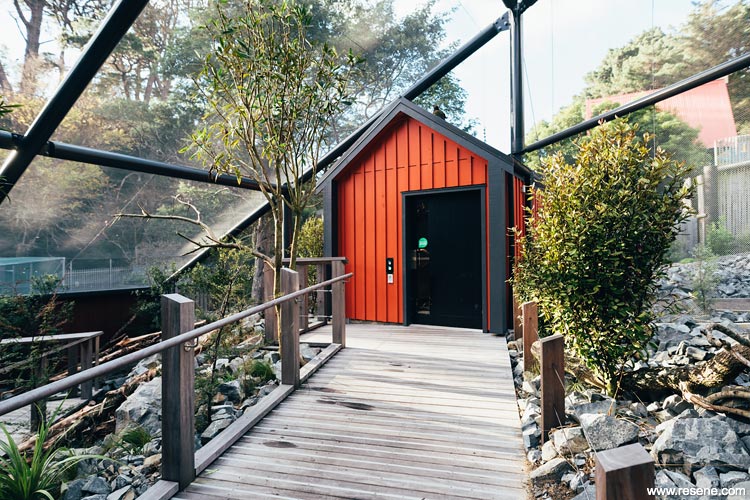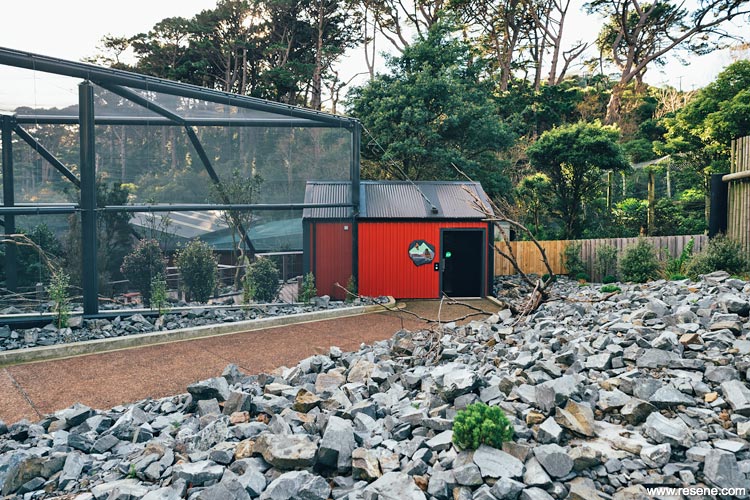Wellington Zoo
Natural darker colours were chosen to make the Kea feel at home...

The zoo's first walk-through alpine aviary
New Zealand is home to a diverse range of environments which support a stunning array of plants and habitats, each with its own unique combination of species. Opened in early 2018 the Kea Enclosure at Wellington Zoo enables visitors the opportunity to interact with these native New Zealand parrots.
The project’s final stage, Mountain Encounter, the zoo’s first walk-through alpine aviary, is a place for guests to enjoy the aerial antics of kea as they fly above and interact within their environment.
Kea are endemic to New Zealand and the world’s only alpine parrot; however due to threats from introduced predators and conflict with humans, they are considered nationally endangered in the wild.
The entrance to the aviary was designed to function as an airlock because of the mischievous nature of the parrots. The security features don’t end there with the aviary netting constructed from high-tensile metal, and every joint 100% Kea-proof. The aviary has proven successful with high visitor numbers. A second aviary accessible through a small hatch allows the Kea to have some quiet time if crowd volumes are too high.
As well as providing humans with an environment to learn about the Kea another function of the facility is to contribute to Kea breeding efforts. With only 1000-5000 wild Kea, the aviary hopes to produce three offspring per year.

The Isthmus design team undertook extensive research of the elements in the Kea’s natural environment and replicated these learnings within the enclosure, as well as continuing the local themes from the Meet the Locals walk at Wellington Zoo.
The Kea aviary is the alpine experience to end the Meet the Locals visitor experience. Colours and plants in this area were drawn heavily from the New Zealand alpine environment.
Natural darker colours were chosen to make the Kea feel at home, and also help to hide any damage the Kea might cause. Resene Woodsman in Resene Dark Oak (mellow brown) is used on roost additions, Resene Sonyx 101 semi-gloss in Resene Redwood (warm brown), Resene CoolColour Black on Hardiboard and external doors and Resene Uracryl in Resene Fuscous Grey (charcoal grey) on exterior structural steel.

The exit trap was chosen as bright Resene Thunderbird (racy deep orange) to match the stables in the Pohutukawa Farm and help reflect on the full experience and walk through of Meet the Locals.
All paints needed to be non-toxic paints as the Kea love to get their beaks into anything and everything.
This project won the Resene Total Landscape Award. The judges said: “The robustness of products and colours aptly reflect the nature of the inhabitants, with a pop of colour anchoring a focal point. The diversity and toughness of materials and the depth of the colour palette brings an appreciation for life in the wild.”
Architectural specifier: Isthmus Group
Building and painting contractor: Hawkins Construction
Client: Wellington Zoo
Photographer: David St. George
Winner: Resene Total Landscape Award
Project: Resene Total Colour Awards 2018
From the Resene News – issue 1/19
Resene case studies/awards project gallery
View case studies that have used Resene products including many from our Resene Total Colour Awards. We hope these projects provide inspiration for decorating projects of your own... view projects
Total Colour Award winners:
2023 |
2022 |
2021 |
2020 |
2019 |
2018 |
2017 |
2016 |
2015 |
2014 |
2013 |
2012 |
2011 |
2010 |
Entry info
Latest projects | Project archive | Resene news archive | Colour chart archive